From Ethnopharmacology to Active Compound: Effects of Traditional Plant Extracts on Varicose Vein-Related Enzymes and Isolation of Active Flavonoids from Helichrysum plicatum DC. subsp. plicatum
Abstract
1. Introduction
2. Results
2.1. Results of Activity-Guided Isolation
2.2. LC-MS/MS Analysis Results
2.3. Results of Enzyme Inhibition Assays
2.4. Results of Antioxidant Activity Assays
3. Discussion
4. Materials and Methods
4.1. Plant Materials and Extraction Methods
4.2. Activity-Guided Isolation Study
4.2.1. Fractionation of EtOAc Extract
4.2.2. Fractionation of Sep. Fr. 50–55
4.2.3. Fractionation of Sep. Fr. 56–80
4.3. LC-MS/MS Analysis Methods
4.4. Microtiter Assays for Enzyme Inhibition
4.5. Antioxidant Activity Assays
4.6. Statistical Analysis
5. Conclusions
Supplementary Materials
Author Contributions
Funding
Institutional Review Board Statement
Informed Consent Statement
Data Availability Statement
Conflicts of Interest
References
- Shahrajabian, M.H.; Sun, W. Five important seeds in Traditional Medicine, and pharmacological benefits. Seeds 2023, 2, 290–308. [Google Scholar] [CrossRef]
- Salm, S.; Rutz, J.; van den Akker, M.; Blaheta, R.A.; Bachmeier, B.E. Current state of research on the clinical benefits of herbal medicines for non-life-threatening ailments. Front. Pharmacol. 2023, 14, 1234701. [Google Scholar] [CrossRef] [PubMed]
- Beebe-Dimmer, J.L.; Pfeifer, J.R.; Engle, J.S.; Schottenfeld, D. The epidemiology of chronic venous insufficiency and varicose veins. Ann. Epidemiol. 2005, 15, 175–184. [Google Scholar] [CrossRef]
- Silva, M.J.; Louzada, A.C.S.; da Silva, M.F.A.; Portugal, M.F.C.; Teivelis, M.P.; Wolosker, N. Epidemiology of 869,220 varicose vein surgeries over 12 years in Brazil: Trends, costs and mortality rate. Ann. Vasc. Surg. 2022, 82, 1–6. [Google Scholar] [CrossRef]
- Bencsik, T.; Balázs, V.L.; Farkas, Á.; Csikós, E.; Horváth, A.; Ács, K.; Kocsis, M.; Doseděl, M.; Fialová, S.B.; Czigle, S. Herbal drugs in chronic venous disease treatment: An update. Fitoterapia 2024, 179, 106256. [Google Scholar] [CrossRef] [PubMed]
- Eberhardt, R.T.; Raffetto, J.D. Chronic venous insufficiency. Circulation 2014, 130, 333–346. [Google Scholar] [CrossRef]
- Wisastra, R.; Dekker, F.J. Inflammation, cancer and oxidative lipoxygenase activity are intimately linked. Cancers 2014, 6, 1500–1521. [Google Scholar] [CrossRef]
- Casili, G.; Lanza, M.; Campolo, M.; Messina, S.; Scuderi, S.; Ardizzone, A.; Filippone, A.; Paterniti, I.; Cuzzocrea, S.; Esposito, E. Therapeutic potential of flavonoids in the treatment of chronic venous insufficiency. Vasc. Pharmacol. 2021, 137, 106825. [Google Scholar] [CrossRef]
- Buján, J.; Gimeno, M.J.; Jiménez, J.A.; Kielty, C.M.; Mecham, R.P.; Bellón, J.M. Expression of elastic components in healthy and varicose veins. World J. Surg. 2003, 27, 901–905. [Google Scholar] [CrossRef]
- Raffetto, J.D.; Khalil, R.A. Mechanisms of lower extremity vein dysfunction in chronic venous disease and implications in management of varicose veins. Vessel Plus 2021, 5, 36. [Google Scholar] [CrossRef]
- Niebes, P. Determination of enzymes and degradation products of glycosaminoglycan metabolism in the serum of healthy and varicose subjects. Clin. Chim. Acta 1972, 42, 399–408. [Google Scholar] [CrossRef]
- Alsaigh, T.; Fukaya, E. Varicose veins and chronic venous disease. Cardiol. Clin. 2021, 39, 567–581. [Google Scholar] [CrossRef]
- Phan, S.H.; Gannon, D.E.; Ward, P.A.; Karmiol, S. Mechanism of neutrophil-induced xanthine dehydrogenase to xanthine oxidase conversion in endothelial cells: Evidence of a role for elastase. Am. J. Respir. Cell Mol. Biol. 1992, 6, 270–278. [Google Scholar] [CrossRef] [PubMed]
- Glowinski, J.; Glowinski, S. Generation of reactive oxygen metabolites by the varicose vein wall. Eur. J. Vasc. Endovasc. Surg. 2002, 23, 550–555. [Google Scholar] [CrossRef] [PubMed]
- Gawas, M.; Bains, A.; Janghu, S.; Kamat, P.; Chawla, P. A comprehensive review on varicose veins: Preventive measures and different treatments. J. Am. Nutr. Assoc. 2022, 41, 499–510. [Google Scholar] [CrossRef]
- Singh, A.; Gattani, R. A Narrative Review of Advancements in Understanding and Treating Varicose Veins. Cureus 2023, 15, e48093. [Google Scholar] [CrossRef]
- Okley, D. Systemic phlebotropic drugs in pharmacotherapy of chronic venous insufficiency of the lower extremities. News Pharm. 2015, 4, 74–77. [Google Scholar] [CrossRef]
- Wadworth, A.N.; Faulds, D. Hydroxyethylrutosides: A review of its pharmacology, and therapeutic efficacy in venous insufficiency and related disorders. Drugs 1992, 44, 1013–1032. [Google Scholar] [CrossRef]
- Büyükyıldırım, T.; Deniz, F.S.Ş. Natural treatment approaches for varicose veins: A brief review of the literature. Trak. Univ. J. Nat. Sci. 2024, 25, 121–132. [Google Scholar] [CrossRef]
- Akgül, G.; Yılmaz, N.; Celep, A.; Celep, F.; Çakılcıoğlu, U. Ethnobotanical purposes of plants sold by herbalists and folk bazaars in the center of Cappadocica (Nevșehir, Turkey). Indian J. Tradit. Knowl. 2016, 15, 103–108. [Google Scholar]
- Karcı, E.; Gürbüz, İ.; Akaydın, G.; Günbatan, T. Folk medicines of Bafra (samsun-Turkey). Turk. J. Biochem. 2017, 42, 381–399. [Google Scholar] [CrossRef]
- Güzel, Y.; Güzelşemme, M.; Miski, M. Ethnobotany of medicinal plants used in Antakya: A multicultural district in Hatay Province of Turkey. J. Ethnopharmacol. 2015, 174, 118–152. [Google Scholar] [CrossRef]
- Günbatan, T.; Gürbüz, İ.; Özkan, A.M.G. The current status of ethnopharmacobotanical knowledge in Çamlıdere (Ankara, Turkey). Turk. J. Bot. 2016, 40, 241–249. [Google Scholar] [CrossRef]
- Korkmaz, M.; Karakuş, S.; Selvi, S. An ethnobotanical study on medicinal plants in Erzincan, Turkey. Indian J. Tradit. Knowl. 2016, 15, 192–202. [Google Scholar]
- Sevgi, E.; Kızılarslan-Hançer, Ç.; Akkaya, M.; Altundağ-Çakır, E.; Büyükkılıç-Altınbaşak, B. An ethnobotanical survey of medicinal plants in Biga (Çanakkale-Turkey). Indian J. Tradit. Knowl. 2022, 21, 583–594. [Google Scholar]
- Korkmaz, M.; Karakurt, E. An ethnobotanical investigation to determine plants used as folk medicine in Kelkit Gümüşhane/Turkey district. Biol. Divers. Conserv. 2015, 8, 290–303. [Google Scholar]
- Akan, H. Kahta (Adıyaman) merkezi ve Narince köyünün etnobotanik açıdan araştırılması. Bitlis Eren Univ. J. Sci. 2015, 4, 219–248. [Google Scholar] [CrossRef]
- Tunalier, Z.; Koşar, M.; Küpeli, E.; Çalış, İ.; Başer, K.H.C. Antioxidant, anti-inflammatory, anti-nociceptive activities and composition of Lythrum salicaria L. extracts. J. Ethnopharmacol. 2007, 110, 539–547. [Google Scholar] [CrossRef]
- Kalankan, G.; Özkan, Z.C.; Akbulut, S. Medicinal and aromatic wild plants and traditional usage of them in Mount Ida (Balıkesir/Turkey). J. Appl. Biol. Sci. 2015, 9, 25–33. [Google Scholar]
- Sargin, S.A.; Büyükcengiz, M. Plants used in ethnomedicinal practices in Gulnar district of Mersin, Turkey. J. Herb. Med. 2019, 15, 100224. [Google Scholar] [CrossRef]
- Kültür, Ş. Medicinal plants used in Kırklareli province (Turkey). J. Ethnopharmacol. 2007, 111, 341–364. [Google Scholar] [CrossRef] [PubMed]
- Backheet, E.Y.; Farag, S.F.; Ahmed, A.S.; Sayed, H.M. Flavonoids and cyanogenic glycosides from the leaves and stem bark of Prunus persica (L.) Batsch (Meet Ghamr) peach local cultivar in Assiut region. Bull. Pharm. Sci. Assiut Univ. 2003, 26, 55–66. [Google Scholar] [CrossRef]
- Sary, H.G.; Ayoub, N.A.; Singab, A.B.; Ahmed, A.H.; Al-Azizi, M.M. Chemical constituents and molluscicidal activity of Iris pseudacorus L. cultivated in Egypt. Bull. Pharm. Sci. Assiut Univ. 2004, 27, 161–169. [Google Scholar] [CrossRef]
- Lin, L.C.; Pai, Y.F.; Tsai, T.H. Isolation of luteolin and luteolin-7-O-glucoside from Dendranthema morifolium Ramat Tzvel and their pharmacokinetics in rats. J. Agric. Food Chem. 2015, 63, 7700–7706. [Google Scholar] [CrossRef]
- Patel, S.K.; Surowiec, S.M. Venous insufficiency. In StatPearls [Internet]; StatPearls Publishing: Treasure Island, FL, USA, 2024. [Google Scholar]
- Stucker, M.; Debus, E.S.; Hoffmann, J.; Jünger, M.; Kröger, K.; Mumme, A.; Ramelet, A.A.; Rabe, E. Consensus statement on the symptom-based treatment of chronic venous diseases. JDDG J. Ger. Soc. Dermatol. 2016, 14, 575–583. [Google Scholar] [CrossRef]
- Gloviczki, P.; Lawrence, P.F.; Wasan, S.M.; Meissner, M.H.; Almeida, J.; Brown, K.R.; Bush, R.L.; Di Iorio, M.; Fish, J.; Fukaya, E. The 2023 Society for Vascular Surgery, American Venous Forum, and American Vein and Lymphatic Society clinical practice guidelines for the management of varicose veins of the lower extremities. Part II: Endorsed by the Society of Interventional Radiology and the Society for Vascular Medicine. J. Vasc. Surg. Venous Lymphat. Disord. 2024, 12, 101670. [Google Scholar]
- Wasan, S. Chronic venous insufficiency evaluation and medical management. Curr. Cardiol. Rep. 2024, 26, 1241–1247. [Google Scholar] [CrossRef]
- Lichota, A.; Gwozdzinski, L.; Gwozdzinski, K. Therapeutic potential of natural compounds in inflammation and chronic venous insufficiency. Eur. J. Med. Chem. 2019, 176, 68–91. [Google Scholar] [CrossRef]
- Pocock, E.S.; Alsaigh, T.; Mazor, R.; Schmid-Schönbein, G.W. Cellular and molecular basis of venous insufficiency. Vasc. Cell 2014, 6, 24. [Google Scholar] [CrossRef]
- Tabeshpour, J.; Imenshahidi, M.; Hosseinzadeh, H. A review of the effects of Berberis vulgaris and its major component, berberine, in metabolic syndrome. Iran. J. Basic Med. Sci. 2017, 20, 557. [Google Scholar]
- Cahlíková, L.; Hulová, L.; Hrabinová, M.; Chlebek, J.; Hošťálková, A.; Adamcová, M.; Šafratová, M.; Jun, D.; Opletal, L.; Ločárek, M. Isoquinoline alkaloids as prolyl oligopeptidase inhibitors. Fitoterapia 2015, 103, 192–196. [Google Scholar] [CrossRef] [PubMed]
- Tarrago, T.; Kichik, N.; Seguí, J.; Giralt, E. The natural product berberine is a human prolyl oligopeptidase inhibitor. ChemMedChem 2007, 2, 354–359. [Google Scholar] [CrossRef]
- Dhouibi, R.; Affes, H.; Salem, M.B.; Hammami, S.; Sahnoun, Z.; Zeghal, K.M.; Ksouda, K. Screening of pharmacological uses of Urtica dioica and others benefits. Prog. Biophys. Mol. Biol. 2020, 150, 67–77. [Google Scholar] [CrossRef]
- Yashaswini, P.; Rao, A.A.; Singh, S.A. Inhibition of lipoxygenase by sesamol corroborates its potential anti-inflammatory activity. Int. J. Biol. Macromol. 2017, 94, 781–787. [Google Scholar] [CrossRef]
- Piwowarski, J.P.; Granica, S.; Kiss, A.K. Lythrum salicaria L.—Underestimated medicinal plant from European traditional medicine. A review. J. Ethnopharmacol. 2015, 170, 226–250. [Google Scholar] [CrossRef]
- Piwowarski, J.P.; Kiss, A.K.; Kozłowska-Wojciechowska, M. Anti-hyaluronidase and anti-elastase activity screening of tannin-rich plant materials used in traditional Polish medicine for external treatment of diseases with inflammatory background. J. Ethnopharmacol. 2011, 137, 937–941. [Google Scholar] [CrossRef] [PubMed]
- Jamshidi, M.; Shabani, E.; Hashemi, Z.; Ebrahimzadeh, M. Evaluation of three methods for the extraction of antioxidants from leaf and aerial parts of Lythrum salicaria L. (Lythraceae). Int. Food Res. J. 2014, 21. [Google Scholar]
- Aydin, T. Secondary metabolites of Helichrysum plicatum DC. subsp. plicatum flowers as strong carbonic anhydrase, cholinesterase and α-glycosidase inhibitors. Z. Naturforsch. C 2020, 75, 153–159. [Google Scholar] [CrossRef] [PubMed]
- Bigović, D.; Šavikin, K.; Janković, T.; Menković, N.; Zdunić, G.; Stanojković, T.; Djurić, Z. Antiradical and cytotoxic activity of different Helichrysum plicatum flower extracts. Nat. Prod. Commun. 2011, 6, 1934578X1100600617. [Google Scholar] [CrossRef]
- Taşkın, T.; Gezmiş, T.; Çam, M.E.; Taşkın, D.; Çelik, B.Ö.; Şenkardeş, İ.; Süzgeç-Selçuk, S. The in vitro and in vivo investigation of biological activities and phenolic analysis of Helichrysum plicatum subsp. plicatum. Braz. J. Pharm. Sci. 2020, 56, e18345. [Google Scholar] [CrossRef]
- Balázs, O.; Dombi, Á.; Zsidó, B.Z.; Hetényi, C.; Valentová, K.; Vida, R.G.; Poór, M. Inhibition of xanthine oxidase-catalyzed xanthine and 6-mercaptopurine oxidation by luteolin, naringenin, myricetin, ampelopsin and their conjugated metabolites. Biomed. Pharmacother. 2023, 167, 115548. [Google Scholar] [CrossRef] [PubMed]
- Iio, M.; Moriyama, A.; Matsumoto, Y.; Takaki, N.; Fukumoto, M. Inhibition of xanthine oxidase by flavonoids. Agric. Biol. Chem. 1985, 49, 2173–2176. [Google Scholar]
- Zhang, X.; Liu, L.; Fan, Z.; Mamadalieva, N.; Liu, C.; Guo, X.; Sun, S.; Sun, H.; Li, N.; Wang, M. Bioactive evaluation of naringenin in ameliorating hyperuricemia-induced liver injury by inhibiting xanthine oxidase. eFood 2025, 6, e70032. [Google Scholar] [CrossRef]
- Su, Z.-R.; Fan, S.-Y.; Shi, W.-G.; Zhong, B.-H. Discovery of xanthine oxidase inhibitors and/or α-glucosidase inhibitors by carboxyalkyl derivatization based on the flavonoid of apigenin. Bioorg. Med. Chem. Lett. 2015, 25, 2778–2781. [Google Scholar] [CrossRef] [PubMed]
- Nessa, F.; Ismail, Z.; Mohamed, N. Xanthine oxidase inhibitory activities of extracts and flavonoids of the leaves of Blumea balsamifera. Pharm. Biol. 2010, 48, 1405–1412. [Google Scholar] [CrossRef]
- Nagao, A.; Seki, M.; Kobayashi, H. Inhibition of xanthine oxidase by flavonoids. Biosci. Biotechnol. Biochem. 1999, 63, 1787–1790. [Google Scholar] [CrossRef] [PubMed]
- Cos, P.; Ying, L.; Calomme, M.; Hu, J.P.; Cimanga, K.; Van Poel, B.; Pieters, L.; Vlietinck, A.J.; Berghe, D.V. Structure–activity relationship and classification of flavonoids as inhibitors of xanthine oxidase and superoxide scavengers. J. Nat. Prod. 1998, 61, 71–76. [Google Scholar] [CrossRef]
- Lin, S.; Zhang, G.; Liao, Y.; Pan, J.; Gong, D. Dietary flavonoids as xanthine oxidase inhibitors: Structure–affinity and structure–activity relationships. J. Agric. Food Chem. 2015, 63, 7784–7794. [Google Scholar] [CrossRef]
- Ali, H.; Ullah, K.; Siddiqui, H.; Iqbal, S.; Goren, N.; Ayatollahi, S.A.; Choudhary, M.I. Chemical constituents from Parrotia persica—Structural derivatization and their potential prolyl endopeptidase inhibition activity. Bioorg. Chem. 2020, 96, 103526. [Google Scholar] [CrossRef]
- Lee, K.-H.; Kwak, J.H.; Lee, K.-B.; Song, K.-S. Prolyl endopeptidase inhibitors from Caryophylli Flos. Arch. Pharm. Res. 1998, 21, 207–211. [Google Scholar] [CrossRef]
- Lee, S.-H.; Jun, M.; Choi, J.-Y.; Yang, E.-J.; Hur, J.-M.; Bae, K.; Seong, Y.-H.; Huh, T.-L.; Song, K.-S. Plant phenolics as prolyl endopeptidase inhibitors. Arch. Pharm. Res. 2007, 30, 827–833. [Google Scholar] [CrossRef] [PubMed]
- Yilmaz, M.A. Simultaneous quantitative screening of 53 phytochemicals in 33 species of medicinal and aromatic plants: A detailed, robust and comprehensive LC–MS/MS method validation. Ind. Crops Prod. 2020, 149, 112347. [Google Scholar] [CrossRef]
- Deniz, F.S.S.; Orhan, I.E.; Filipek, P.A.; Ertas, A.; Gstir, R.; Jakschitz, T.; Bonn, G.K. Evaluation of the anti-aging properties of ethanolic extracts from selected plant species and propolis by enzyme inhibition assays and 2D/3D cell culture methods. Pharmaceuticals 2025, 18, 439. [Google Scholar] [CrossRef]
- Kraunsoe, J.A.; Claridge, T.D.; Lowe, G. Inhibition of human leukocyte and porcine pancreatic elastase by homologues of bovine pancreatic trypsin inhibitor. Biochemistry 1996, 35, 9090–9096. [Google Scholar] [CrossRef]
- Lee, S.; Sandesh, S.; Shruti, S.; Seo, S. Potent antielastase and antityrosinase activities of Astilbe chinensis. Am. J. Pharmacol. Toxicol. 2009, 4, 127–129. [Google Scholar] [CrossRef]
- Barrantes, E.; Guinea, M.a. Inhibition of collagenase and metalloproteinases by aloins and aloe gel. Life Sci. 2003, 72, 843–850. [Google Scholar] [CrossRef]
- Van Wart, H.E.; Steinbrink, D.R. A continuous spectrophotometric assay for Clostridium histolyticum collagenase. Anal. Biochem. 1981, 113, 356–365. [Google Scholar] [CrossRef] [PubMed]
- Chung, L.Y.; Soo, W.K.; Chan, K.Y.; Mustafa, M.R.; Goh, S.H.; Imiyabir, Z. Lipoxygenase inhibiting activity of some Malaysian plants. Pharm. Biol. 2009, 47, 1142–1148. [Google Scholar] [CrossRef]
- Khan, S.B.; Afza, N.; Malik, A.; Azhar-Ul-Haq; Perveen, S.; Ahmad, I.; Ejaz, A.; Iqbal Choudhary, M. Xanthine oxidase inhibiting flavonol glycoside from Amberboa ramosa. Nat. Prod. Res. 2006, 20, 335–339. [Google Scholar] [CrossRef]
- Duh, P.-D.; Tu, Y.-Y.; Yen, G.-C. Antioxidant activity of water extract of Harng Jyur (Chrysanthemum morifolium Ramat). LWT–Food Sci. Technol. 1999, 32, 269–277. [Google Scholar] [CrossRef]
- Miser-Salihoglu, E.; Akaydin, G.; Caliskan-Can, E.; Yardim-Akaydin, S. Evaluation of antioxidant activity of various herbal folk medicines. J. Nutr. Food. Sci. 2013, 3, 222. [Google Scholar]
- Sreejayan, X.; Rao, M. Nitric oxide scavenging by curcuminoids. J. Pharm. Pharmacol. 1997, 49, 105–107. [Google Scholar] [CrossRef] [PubMed]
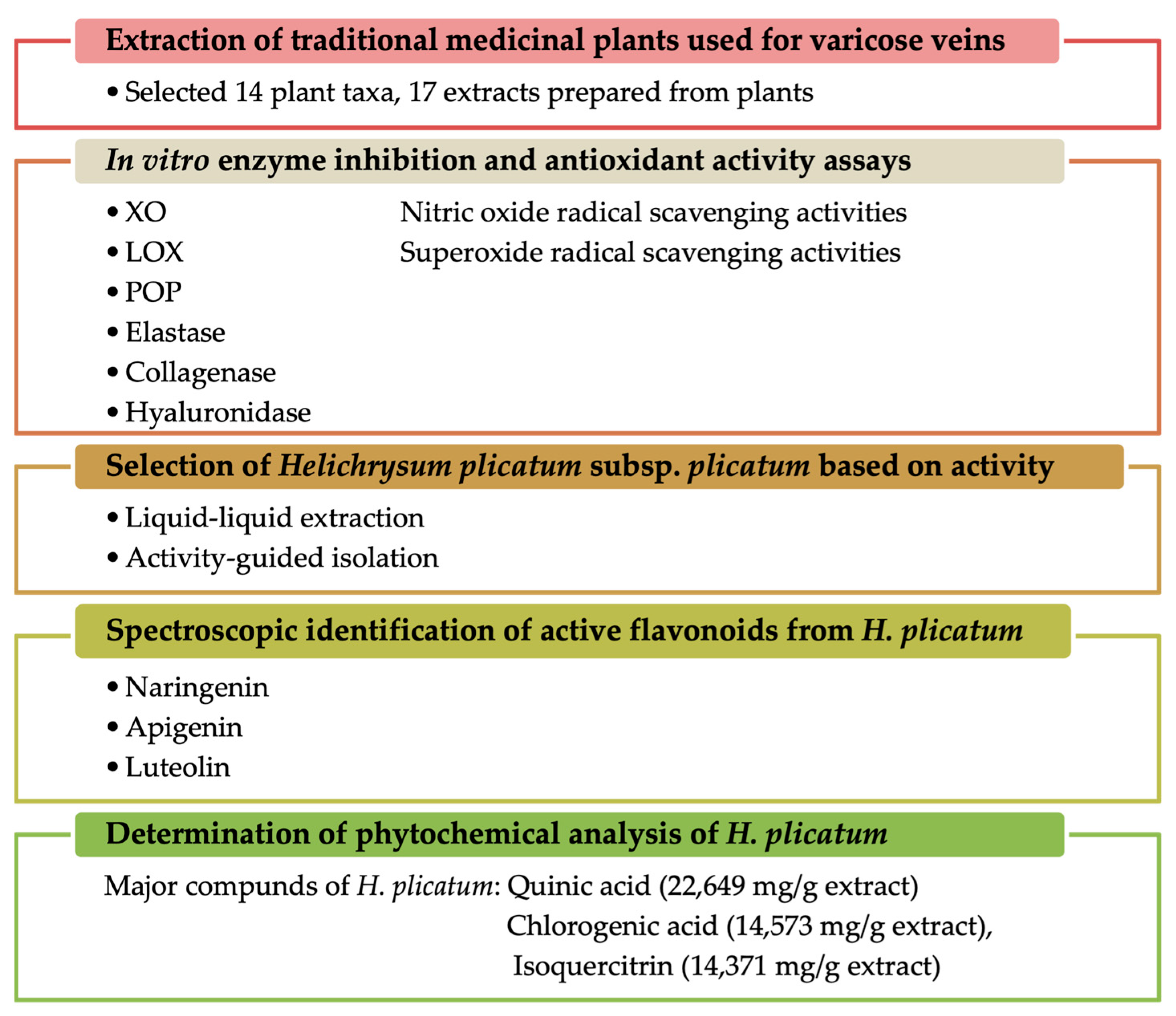
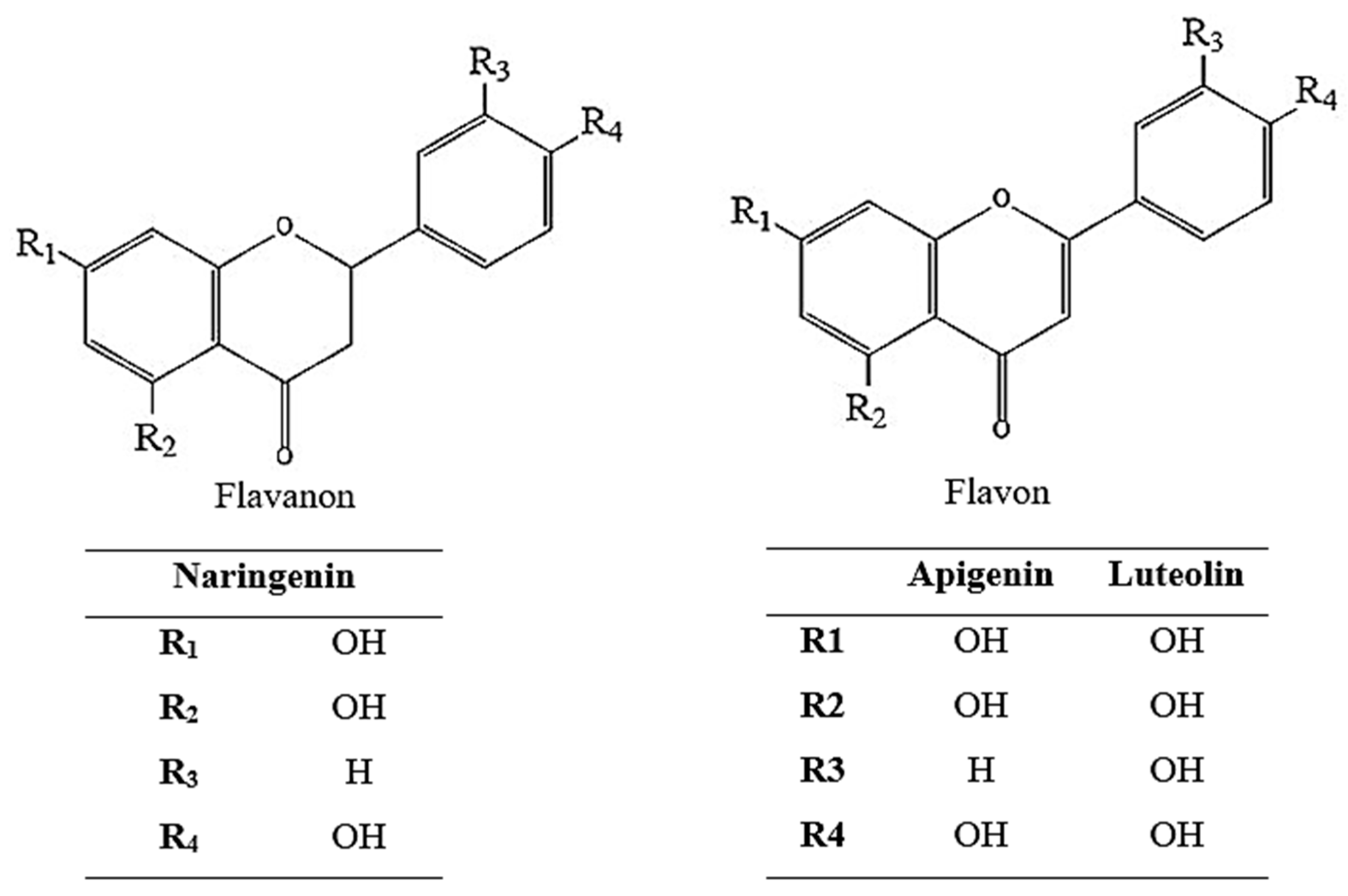
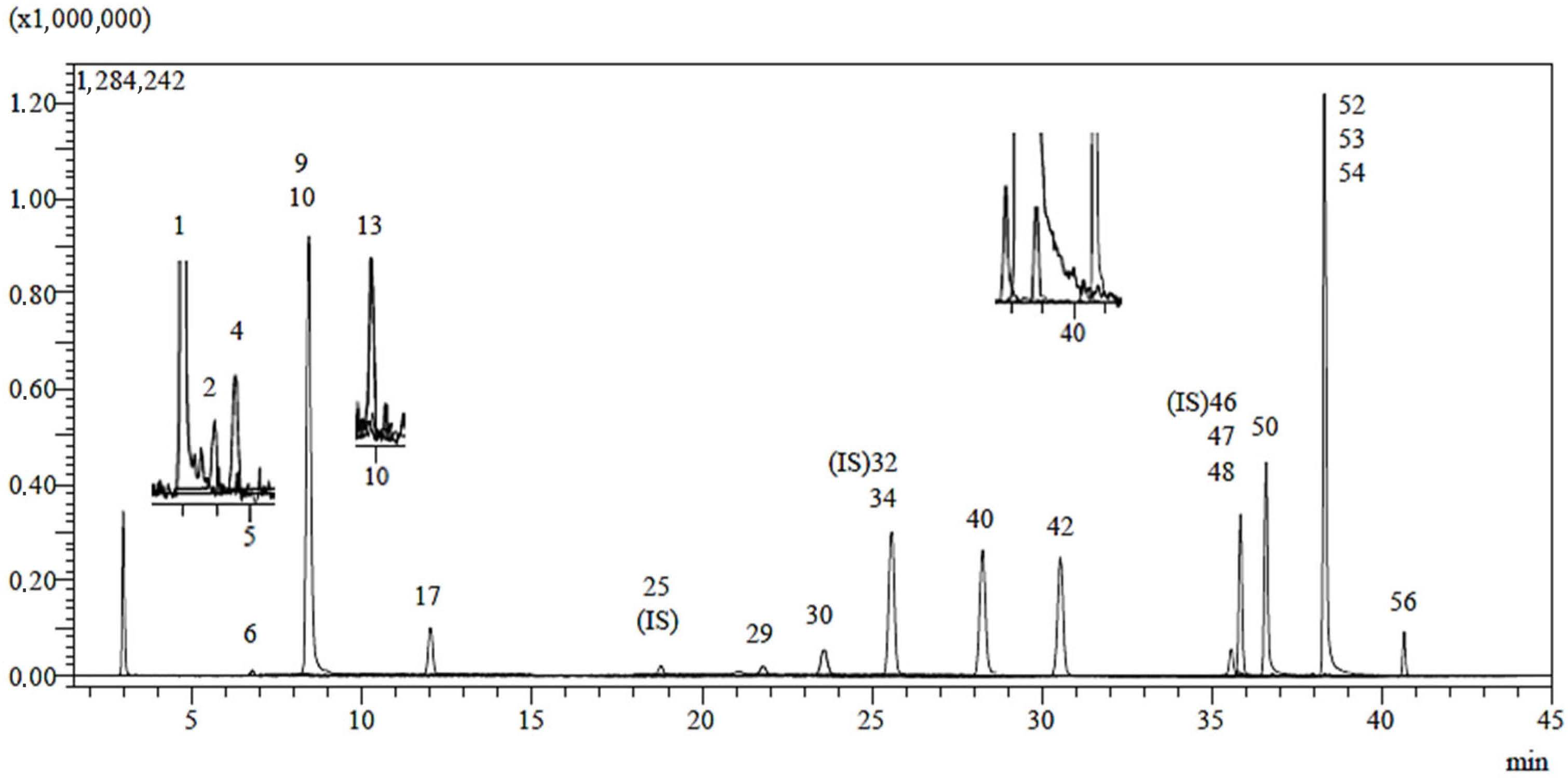
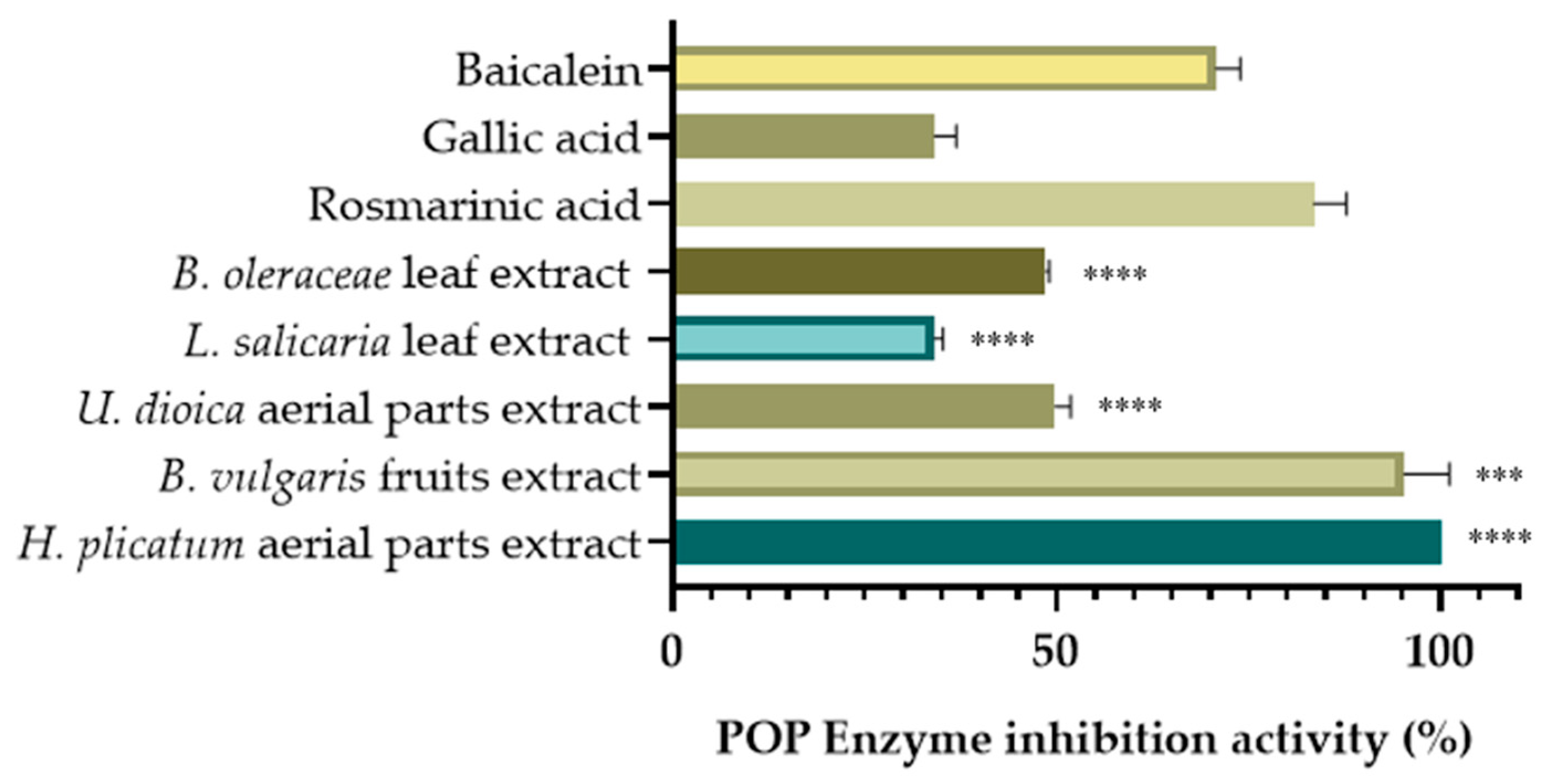
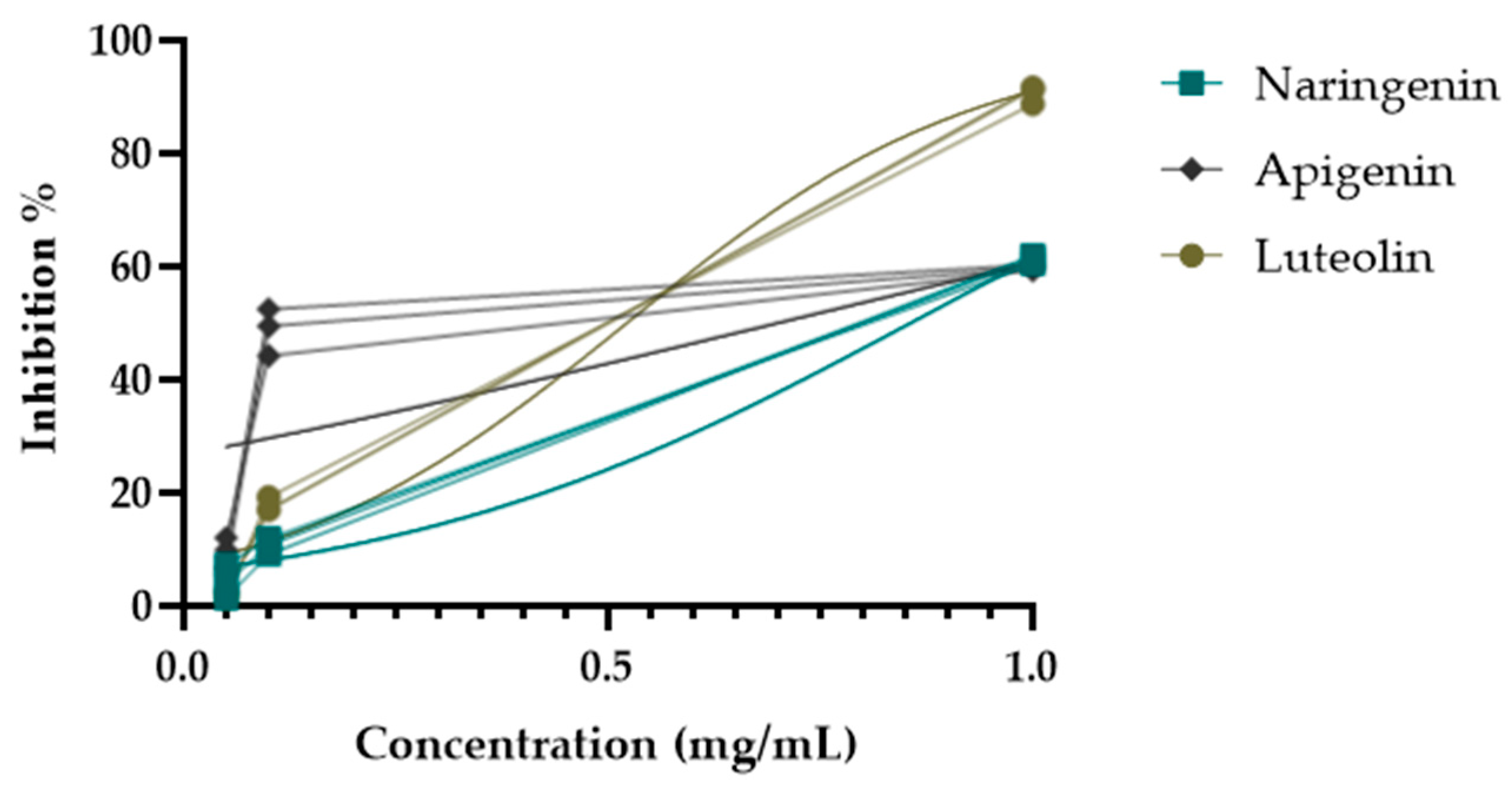
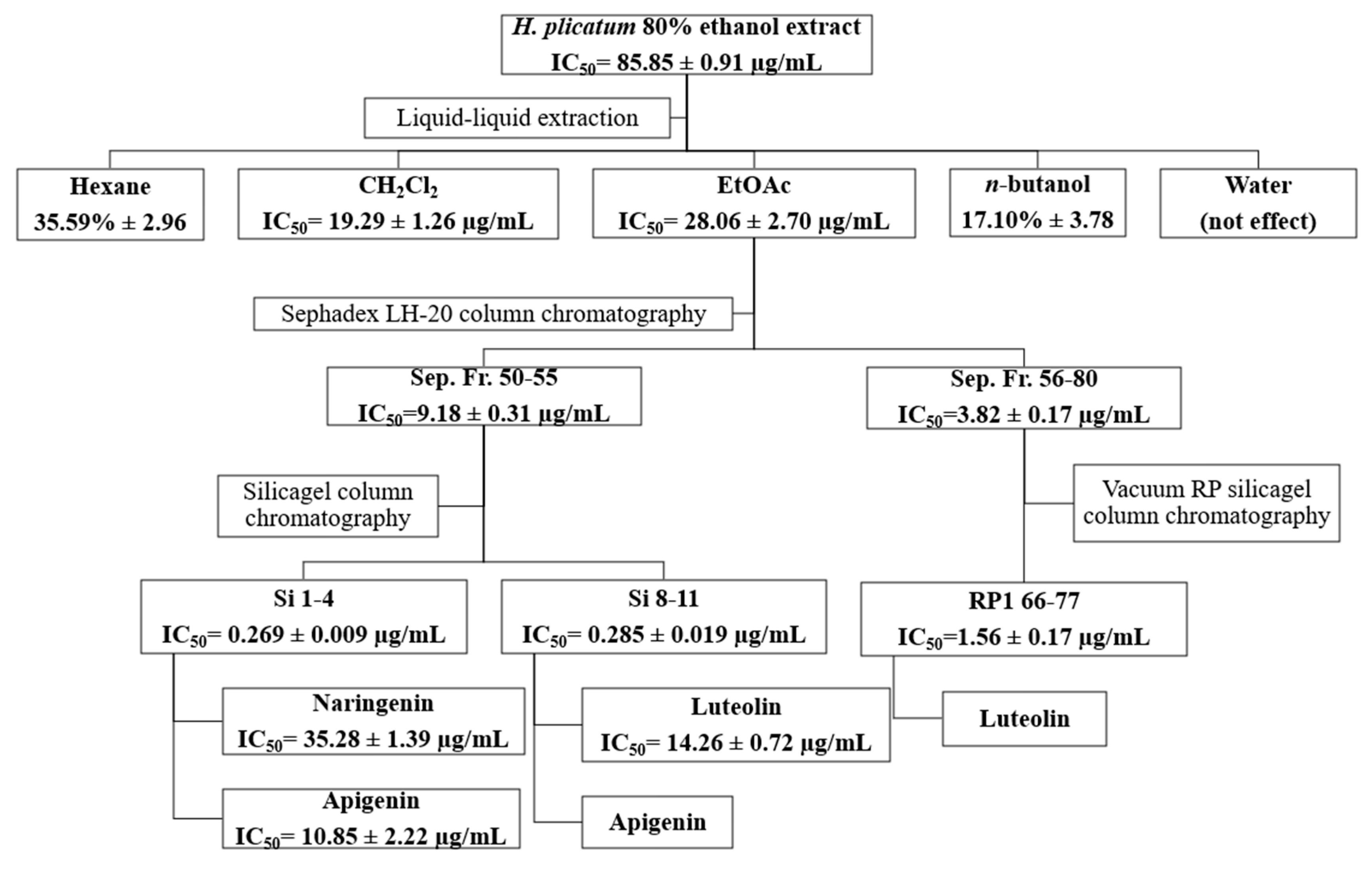

| Carbon | Naringenin | Apigenin | Luteolin | |||
|---|---|---|---|---|---|---|
| δC | δH | δC | δH | δC | δH | |
| C-2 | 78.87 | 5.44 (d, J = 12.5 Hz) | 164.11 | - | 165.71 | - |
| C-3 | 42.44 | 3.26 (m), 2.72 (dd, J = *, 17.1) | 99.45 | 6.17 (br s) | 102.40 | 6.57 (s) |
| C-4 | 196.63 | - | 182.12 | - | 182.9 | - |
| C-5 | 163.95 | 12.15 (s) | 161.91 | 12.96 (s) | 164.42 | 13.03 (s) |
| C-6 | 96.31 | 5.87 (br s) | 94.50 | 6.46 (d, J = 2.5 Hz) | 99.82 | 6.12 (br s) |
| C-7 | 165.62 | 12.15 (s) | 165.27 | 12.96 (s) | 166.13 | 13.03 (s) |
| C-8 | 95.49 | 5.87 (br s) | 103.22 | 6.77 (d, J = 2.5 Hz) | 94.41 | 6.38 (br s) |
| C-9 | 163.39 | - | 103.92 | - | 161.84 | - |
| C-10 | 102.14 | - | 157.82 | - | 103.43 | - |
| C-1′ | 129.96 | - | 121.57 | - | 120.61 | - |
| C-2′ | 128.79 | 7.31 (d, J = 8.3 Hz) | 128.90 | 7.92 (d, J = 8 Hz) | 113.31 | 7.32 (m) |
| C-3′ | 115.62 | 6.79 (d, J = 8.1 Hz) | 116.45 | 6.93 (d, J = 8 Hz) | 146.81 | - |
| C-4′ | 158.20 | - | 161.79 | 10.78 (s) | 151.96 | - |
| C-5′ | 115.62 | 6.79 (d, J = 8.1 Hz) | 116.45 | 6.93 (d, J = 8 Hz) | 116.40 | 6.82 (d, J = 7.2 Hz) |
| C-6′ | 128.79 | 7.31 (d, J = 8.3 Hz) | 128.90 | 7.92 (d, J = 8 Hz) | 119.32 | 7.32 m |
| No. | Analyte | R.T. a | M.I. (m/z) b | Ion. Mode | Equation | r2 c | LOD/LOQ (µg/L) d | mg/g Extract |
|---|---|---|---|---|---|---|---|---|
| 1 | Quinic acid | 3.0 | 190.8 | Neg | y = −0.0129989 + 2.97989× | 0.996 | 25.7/33.3 | 22.649 |
| 2 | Fumaric aid | 3.9 | 115.2 | Neg | y = −0.0817862 + 1.03467x | 0.995 | 135.7/167.9 | 0.656 |
| 4 | Gallic acid | 4.4 | 168.8 | Neg | y = 0.0547697 + 20.8152x | 0.999 | 13.2/17.0 | 0.021 |
| 6 | Protocatechuic acid | 6.8 | 152.8 | Neg | y = 0.211373 + 12.8622x | 0.957 | 21.9/38.6 | 0.236 |
| 9 | Chlorogenic acid | 8.4 | 353.0 | Neg | y = 0.289983 + 36.3926x | 0.995 | 13.1/17.6 | 14.573 |
| 10 | Protocatechuic aldehyde | 8.5 | 137.2 | Neg | y = 0.257085 + 25.4657x | 0.996 | 15.4/22.2 | 0.069 |
| 13 | 1,5-dicaffeoylquinic acid | 9.8 | 515.0 | Neg | y = −0.0164044 + 16.6535x | 0.999 | 5.8/9.4 | 0.055 |
| 17 | Caffeic acid | 12.1 | 179.0 | Neg | y = 0.120319 + 95.4610x | 0.999 | 7.7/9.5 | 0.544 |
| 29 | Salicylic acid | 21.8 | 137.2 | Neg | y = 0.239287 + 153.659x | 0.999 | 6.0/8.3 | 0.032 |
| 30 | Cyranoside | 23.7 | 447.0 | Neg | y = 0.280246 + 6.13360x | 0.997 | 12.1/16.0 | 1.634 |
| 34 | Isoquercitrin | 25.6 | 463.0 | Neg | y = −0.111120 + 4.10546x | 0.998 | 8.7/13.5 | 14.371 |
| 40 | Cosmosiin | 28.2 | 431.0 | Neg | y = −0.708662 + 8.62498x | 0.998 | 6.3/9.2 | 9.885 |
| 42 | Astragalin | 30.4 | 447.0 | Neg | y = 0.00825333 + 3.51189x | 0.999 | 6.6/8.2 | 11.506 |
| 47 | Quercetin | 35.7 | 301.0 | Neg | y = 0.00597342 + 3.39417x | 0.999 | 15.5/19.0 | 0.319 |
| 48 | Naringenin | 35.9 | 270.9 | Neg | y = −0.00393403 + 14.6424x | 0.999 | 2.6/3.9 | 1.457 |
| 50 | Luteolin | 36.7 | 284.8 | Neg | y = −0.0541723 + 30.7422x | 0.999 | 2.6/4.1 | 1.368 |
| 52 | Kaempferol | 37.9 | 285.0 | Neg | y = −0.00459557 + 3.13754x | 0.999 | 10.2/15.4 | 0.091 |
| 53 | Apigenin | 38.2 | 268.8 | Neg | y = 0.119018 + 34.8730x | 0.998 | 1.3/2.0 | 2.518 |
| 54 | Amentoflavone | 39.7 | 537.0 | Neg | y = 0.727280 + 33.3658x | 0.992 | 2.8/5.1 | 0.003 |
| 56 | Acacetin | 40.7 | 283.0 | Neg | y = −0.559818 + 163.062x | 0.997 | 1.5/2.5 | 0.005 |
| Enzyme Inhibition (% Inhibition ± S.D a) | |||||
|---|---|---|---|---|---|
| Samples | Parts | XO 100 µg/mL b | LOX 100 µg/mL b | Collagenase 133.33 µg/mL b | Hyaluronidase 166.66 µg/mL b |
| Berberis vulgaris | Flos | 26.52 ± 5.35 **** | - c | - | 59.12 ± 5.60 d **** |
| Fruit | 24.13 ± 0.66 **** | - | 29.16 ± 4.24 **** | 70.10 ± 4.96 **** (IC50 = 114.63 ± 5.86 µg/mL) | |
| Brassica oleraceae var. acephala | Leaf | 7.89 ± 1.92 **** | - | - | 75.60 ± 10.68 ** (IC50 = 124.85 ± 0.64 µg/mL) |
| Capsella bursa pastoris | Aerial part | 16.74 ± 5.99 **** | 16.07 ± 3.34 **** | - | 42.02 ± 10.02 **** |
| Lamium album | Aerial part | 13.35 ± 3.06 **** | - | - | 7.74 ± 2.11 **** |
| Plantago major | Leaf | 28.57 ± 2.27 **** | - | - | - |
| Urtica dioica | Aerial part | 21.16 ± 2.26 **** | 45.82 ± 2.48 **** | - | - |
| Capsicum annuum | Fruit | 10.81 ± 5.60 **** | 20.21 ± 1.80 **** | - | 42.05 ±1.54 **** |
| Helychrysum plicatum subsp. plicatum | Aerial part | 60.15 ± 0.65 **** (IC50 = 85.85 ± 0.91 µg/mL) | - | 2.12 ± 0.44 **** | 47.29 ± 3.12 **** |
| Sesamum indicum | Seed | 17.20 ± 1.93 **** | 41.07 ± 3.77 **** | - | 39.05 ± 3.95 **** |
| Sambucus ebulus | Flos | 20.80 ± 0.34 **** | - | - | 41.80 ± 4.19 **** |
| Leaf | 23.32 ± 3.74 **** | - | - | 64.56 ± 4.94 **** (IC50 = 139.55 ± 5.48 µg/mL) | |
| Crataegus monogyna | Leaf | 31.86 ± 3.91 | - | - | - |
| Fruit | 10.78 ± 4.13 | - | - | - | |
| Lythrum salicaria | Leaf | 27.64 ± 2.51 **** | - | - | 84.60 ± 3.76 (IC50 = 70.76 ± 3.34 µg/mL) |
| Ecballium elaterium | Fruit | 12.77 ± 1.57 **** | - | - | - |
| Plantago lanceolata | Leaf | 31.17 ± 1.71 **** | - | - | - |
| References (1 mg/mL) | 91.58 ± 1.30 e (IC50 = 0.250 ± 0.006 µg/mL) | 60.10 ± 2.39 f (IC50 = 41.84 ± 1.35) | 87.39 ± 2.85 g (IC50 = 27.95 ± 0.3 µg/mL) | 92.51 ± 3.53 h (IC50 = 2.31 ± 0.73 µg/mL) | |
| Enzyme Inhibition (% Inhibition ± S.D a) | ||||
|---|---|---|---|---|
| Sub-Extract | XO 100 µg/mL b | LOX 100 µg/mL b | Collagenase 133.33 µg/mL b | Hyaluronidase 166.66 µg/mL b |
| n-hexane | 35.59 ± 2.96 **** | 39.87 ± 1.17 **** | - c | 79.32 ± 3.21 d ** |
| Dichloromethane | 74.80 ± 1.63 **** (IC50 = 19.29 ± 1.26 µg/mL) | 2.16 ± 0.61 **** | 11.37 ± 2.33 | - |
| EtOAc | 70.44 ± 4.32 **** (IC50 = 28.06 ± 2.70 µg/mL) | - | - | 76.28 ± 4.10 d *** |
| n-butanol | 17.10 ± 3.78 **** | - | - | 58.41 ± 6.27 d **** |
| Water | - | - | - | - |
| References (1 mg/mL) | 91.58 ± 1.30 e (IC50 = 0.250 ± 0.006 µg/mL) | 60.10 ± 2.39 f (IC50 = 41.84 ± 1.35) | 87.39 ± 2.85 g (IC50 = 27.95 ± 0.37 µg/mL) | 92.51 ± 3.53 h (IC50 = 2.31 ± 0.73 µg/mL) |
| Fraction | XO Enzyme Inhibition (% Inhibition ± S.D. a) 100 µg/mL b | |
|---|---|---|
| Fractions from Sephadex LH-20 column chromatography | Sep. Fr. 1–7 | 27.62 ± 2.21 **** |
| Sep. Fr. 8–14 | 10.34 ± 1.71 **** | |
| Sep. Fr. 15–22 | 11.96 ± 2.58 **** | |
| Sep. Fr. 23–28 | 22.73 ± 1.49 **** | |
| Sep. Fr. 29–39 | 38.73 ± 3.07 **** | |
| Sep. Fr. 40–49 | 62.97 ± 5.74 (IC50 = 49.39 ± 1.17 µg/mL) **** | |
| Sep. Fr. 50–55 | 89.98 ± 2.44 (IC50 = 9.18 ± 0.31 µg/mL) | |
| Sep. Fr. 56–80 | 90.54 ± 2.14 (IC50 = 3.82 ± 0.17 µg/mL) | |
| Fractions from silica gel column chromatography | Si 1–4 | 92.67 ± 1.60 c (IC50 = 0.269 ± 0.009 µg/mL) |
| Si 5 | 77.95 ± 3.79 d (IC50 = 0.421 ± 0.046 µg/mL) **** | |
| Si 6–7 | 97.63 ± 0.13 (IC50 = 1.342 ± 0.255 µg/mL) * | |
| Si 8–11 | 93.83 ± 3.18 c (IC50 = 0.285 ± 0.019 µg/mL) | |
| Si 12–25 | 96.72 ± 1.22 (IC50 = 3.165 ± 0.440 µg/mL) | |
| Si 26–29 | 83.93 ± 3.59 e (IC50 = 3.978 ± 0.293 µg/mL) ** | |
| Si 30–33 | 82.82 ± 4.17 e (IC50 = 4.866 ± 0.205 µg/mL) *** | |
| Si 35–37 | 93.46 ± 2.72 c (IC50 = 5.895 ± 0.079 µg/mL) | |
| Si 38–42 | 13.86 ± 0.28 **** | |
| Si 43–46 | 76.02 ± 1.66 (IC50 = 33.868 ± 3.760 µg/mL) **** | |
| Si 47–51 | 82.83 ± 2.50 (IC50 = 6.955 ± 0.496 µg/mL) *** | |
| Si 52–58 | 84.64 ± 3.93 (IC50 = 34.035 ± 1.558 µg/mL) * | |
| Si 59–60 | 76.92 ± 4.38 (IC50 = 54.013 ± 2.826 µg/mL) **** | |
| Fractions from vacuum reverse-phase silica gel column chromatography | RP1 21–27 | 71.44 ± 0.43 (IC50 = 49.72 ± 0.39 µg/mL) **** |
| RP1 37–39 | 72.56 ± 3.29(IC50 = 37.02 ± 1.76 µg/mL) **** | |
| RP1 51–55 | 92.11 ± 2.00 (IC50 = 2.49 ± 2.49 µg/mL) | |
| RP1 66–77 | 95.46 ± 0.07 (IC50 = 1.56 ± 0.17 µg/mL) * | |
| Reference | Allopurinol c | 91.58 ± 1.30 (0.250 ± 0.006 µg/mL) |
| Sample | Part | Nitric Oxide Radical-Scavenging Activity (% Inhibition ± S.D. a) 2 mg/mL b | Superoxide Radical-Scavenging Activity (Vitamin C Equivalent) 2 mg/mL b |
|---|---|---|---|
| Berberis vulgaris | Flower | 75.95 ± 0.17 **** (IC50 = 225.50 ± 6.79 µg/mL) | 39.76 |
| Fruit | 67.88 ± 7.27 **** (IC50 = 326.70 ± 4.10 µg/mL) | 48.33 | |
| Brassica oleraceae var. acephala | Leaf | 44.52 ± 1.04 **** | 0.003 |
| Capsella bursa pastoris | Aerial part | 53.15 ± 3.51 **** (IC50 = 433.25 ± 11.53 µg/mL) | 1.3 |
| Lamium album | Aerial part | 70.72 ± 0.43 **** (IC50 = 315.00 ± 5.52 µg/mL) | 3.56 |
| Plantago major | Leaf | 79.31 ± 0.86 **** (IC50 = 208.30 ± 3.68 µg/mL) | 15.80 |
| Urtica dioica | Aerial part | 47.18 ± 1.28 **** | 1.97 |
| Capsicum annuum | Fruit | 36.04 ± 0.95 **** | 0.19 |
| Helychrysum plicatum subsp. plicatum | Aerial part | 82.66 ± 0.36 ** (IC50 = 152.70 ± 3.68 µg/mL) | 73.38 |
| Sesamum indicum | Seed | 51.90 ± 0.00 **** (IC50 = 488.73 ± 0.81 µg/mL) | 0.17 |
| Crataegus monogyna subsp. monogyna | Fruit | 53.27 ± 4.58.**** (IC50 = 499.80 ± 0.14 µg/mL) | 4,54 |
| Leaf | 81.30 ± 0.20 *** (IC50 = 165.05 ± 0.07 µg/mL) | 80.09 | |
| Sambucus ebulus | Flower | 74.07 ± 1.40 **** (IC50 = 270.70 ± 1.98 µg/mL) | 3.29 |
| Leaf | 72.54 ± 1.19 **** (IC50 = 312.70 ± 4.68 µg/mL) | 4.96 | |
| Lythrum salicaria | Leaf | 86.58 ± 0.55 (IC50 = 133.00 ± 6.79 µg/mL) | 274.77 |
| Ecballium elaterium | Fruit | 59.86 ± 1.88 **** (IC50 = 432.40 ± 0.57 µg/mL) | 0.08 |
| Plantago lanceolata | Leaf | 78.91 ± 3.39 **** (IC50 = 260.40 ± 1.70 µg/mL) | 6.58 |
| Vitamin C (1 mg/mL) | 92.72 ± 0.10 (IC50 = 25.28 ± 2.98 µg/mL) | - |
| Plant Material | Part | Yield% (w/w) | Family | Region | Preparation Method | Usage |
|---|---|---|---|---|---|---|
| Berberis vulgaris L. | Fruit | 25.58 | Berberidaceae | Cappadocia | Decoction | Oral [20] |
| Flowers | 25.74 | |||||
| Brassica oleraceae var. acephala | Leaf | 40.88 | Brassicaceae | Samsun | Decoction | Topical [21] |
| Capsella bursa pastoris (L.) Medik. | Aerial part | 8.00 | Brassicaceae | Hatay | Decoction | Oral [22] |
| Capsicum annuum L. | Fruit | 31.63 | Solanaceae | Ankara | Boiled with bran flour | - * [23] |
| Crataegus monogyna Jacq. subsp. monogyna | Fruit | 20.10 | Rosaceae | Erzincan | - | - [24] |
| Leaf | 25.73 | |||||
| Ecballium elaterium (L.) A.Rich. | Fruit | 15.03 | Cucurbitaceae | Çanakkale | - | - [25] |
| Helichrysum plicatum DC. subsp. plicatum | Aerial part | 10.84 | Asteraceae | Gümüşhane | - | - [26] |
| Lamium album L. | Aerial part | 11.35 | Lamiaceae | Adıyaman | - | Topical [27] |
| Lythrum salicaria L. | Leaf | 11.54 | Lythraceae | - | Decoction | Topical [28] |
| Plantago lanceolata L. | Leaf | 11.83 | Plantaginaceae | Balıkesir | Infusion | Topical [29] |
| Plantago major subsp. major L. | Leaf | 14.08 | Plantaginaceae | Balıkesir | Infusion | Topical [29] |
| Sambucus ebulus L. | Flowers | 38.06 | Viburnaceae | Samsun | - | Topical [21] |
| Leaf | 18.92 | |||||
| Sesamum indicum L. | Seed (fixed oil) | 7.31 | Pedaliaceae | Mersin | - | - [30] |
| Urtica dioica L. | Aerial part | 7.09 | Urticaceae | Kırklareli | Decoction | Topical [31] |
Disclaimer/Publisher’s Note: The statements, opinions and data contained in all publications are solely those of the individual author(s) and contributor(s) and not of MDPI and/or the editor(s). MDPI and/or the editor(s) disclaim responsibility for any injury to people or property resulting from any ideas, methods, instructions or products referred to in the content. |
© 2025 by the authors. Licensee MDPI, Basel, Switzerland. This article is an open access article distributed under the terms and conditions of the Creative Commons Attribution (CC BY) license (https://creativecommons.org/licenses/by/4.0/).
Share and Cite
Buyukyildirim, T.; Deniz, F.S.S.; Baran, M.Y.; Salihoglu, E.; Yilmaz, M.A.; Tugay, O. From Ethnopharmacology to Active Compound: Effects of Traditional Plant Extracts on Varicose Vein-Related Enzymes and Isolation of Active Flavonoids from Helichrysum plicatum DC. subsp. plicatum. Pharmaceuticals 2025, 18, 926. https://doi.org/10.3390/ph18060926
Buyukyildirim T, Deniz FSS, Baran MY, Salihoglu E, Yilmaz MA, Tugay O. From Ethnopharmacology to Active Compound: Effects of Traditional Plant Extracts on Varicose Vein-Related Enzymes and Isolation of Active Flavonoids from Helichrysum plicatum DC. subsp. plicatum. Pharmaceuticals. 2025; 18(6):926. https://doi.org/10.3390/ph18060926
Chicago/Turabian StyleBuyukyildirim, Tugsen, F. Sezer Senol Deniz, Merve Yuzbasioglu Baran, Ece Salihoglu, Mustafa Abdullah Yilmaz, and Osman Tugay. 2025. "From Ethnopharmacology to Active Compound: Effects of Traditional Plant Extracts on Varicose Vein-Related Enzymes and Isolation of Active Flavonoids from Helichrysum plicatum DC. subsp. plicatum" Pharmaceuticals 18, no. 6: 926. https://doi.org/10.3390/ph18060926
APA StyleBuyukyildirim, T., Deniz, F. S. S., Baran, M. Y., Salihoglu, E., Yilmaz, M. A., & Tugay, O. (2025). From Ethnopharmacology to Active Compound: Effects of Traditional Plant Extracts on Varicose Vein-Related Enzymes and Isolation of Active Flavonoids from Helichrysum plicatum DC. subsp. plicatum. Pharmaceuticals, 18(6), 926. https://doi.org/10.3390/ph18060926









